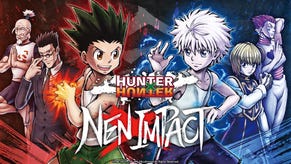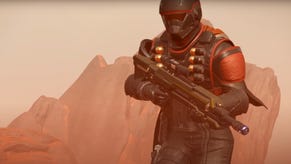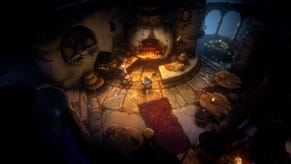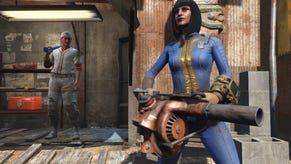A history of violence: Harada on his Tekken career
Tekken has been a fighting institution since the series launched across arcades in 1994. Dave Cook speaks with chief producer Katsuhiro Harada on the series's birth and evolution.
The original Tekken is the reason many gamers bought their first PlayStation. Namco's fighter helped to drive a wedge between 16-bit consoles and Sony's juggernaut, proving that the age of SNES and Mega Drive was coming to a close.
While Sega and Nintendo scrambled around with CD add-ons, Super FX Chips and 32X ports, Sony and Namco were forging a partnership that would see the Tekken series become one of the PlayStation's flagship brands.
Today the series boasts six core instalments, a handful of movie tie-ins and a dedicated fan base. Namco's most recent release Tekken Tag Tournament 2 launched in September, and at the start of November Namco revealed that it had sold close to a million copies.
There's clearly a lot of love for the series out there today, so VG247 spoke with Namco's chief producer of fighting games Katsuhiro Harada to discuss Tekken's legacy, and how he helped mould it into one of the most iconic brawlers of our time.
Polygon consideration
Harada truly is one of those 'rockstar' developers that the gaming populace knows by name and face alone. He frequents fighting tournaments, speaks with fans regularly over Twitter, and of course he really does know his fighting games.
Things didn't always start out this way for the developer. In fact, the original Tekken started out as an experiment into modelling with polygons and was never intended to be a fighting game at all. That decision only came after Harada and the team saw the potential of the arcade tech it was working with.
Harada recalled, "Originally, Tekken was not assumed to be a fighting game in modern times. but it had more of a meaning in investigating '3D model animation control' and 'shaping human body polygons' that would be needed in the years to come, since at that time we were still in the pre-dawn of polygons.
"For that reason, many human resources came together at Namco and started to do basic research, which was the catalyst." That 'catalyst' would see Tekken created for arcades and launched in December 1994, and by this point Harada and his team had already been tinkering around with the brand new PlayStation hardware in order to create a home port for release in 1995.
“Technology wise, we couldn’t do the scaling for the lower body of Jack, so that is why his upper body is so big with such a small lower body. In addition to that, he has an infinite combo. That’s not even fixed. Don’t you think that’s awful?”
"Namco was originally a development company for arcade games," Harada explained. "Before the PlayStation console was released, we were co-developing the arcade board called SYSTEM 11 with Sony and already had the arcade working, so I could say that the change to PlayStation was smooth.
Harada added, "The technological challenges were that it was the first fighting game using texture on the polygons, and 60FPS portrayals," underlining that Namco was - at the time - working at what was the bleeding edge of early PlayStation technology.
Visuals and high frame rate are one thing, but as Harada suggests, his team weren't yet the fighting game maestros they are today, and as such character creation proved problematic, "As for the adjustment in the characters, we didn’t have any know-how at that time, making it disastrous. So it could be said that none of the characters were fun and all of them were difficult."
One character in particular caused Harada and his team a lot of grief, "Actually, technology wise, we couldn’t do the scaling for the lower body of Jack, so that is why his upper body is so big with such a small lower body. In addition to that, he has an infinite combo. That’s not even fixed. Don’t you think that's awful? Mostly all the characters had a combo that made the opponent instantly down."
Ah the dreaded infinite combos. Even then they were a thorn in Namco's backside. But regardless Harada and his team were confident that Tekken would be a big success, and Sony was backing them every step of the way. "Everyone was feeling the new era," Harada recalled. "Especially for the polygon technology, Namco was one or two steps ahead of everyone in the world, and both Sony and Namco understood that.
"A while later, Mr. Kutaragi - who was president at Sony at that time - wrote in his book that one of the three keys in making PlayStation a success was to collaborate with Namco. That was probably true indeed."
Tekken take two
After Tekken proved to be a big hit on PlayStation, while seeing less-than-expected returns in arcades, it was clear to Namco and Sony that the series should remain on the console. Harada's team was commissioned to create a sequel as soon as work wrapped on the original, and then ambition for the franchise started to run hot.
With Tekken 2, Harada started to put his understanding of the fighting genre to the test. He explained, "The goal was to gain status as a fighting game, as well as aiming for a benchmark title to prove development and technological power, putting in as much new technology as possible.
"As for the hardware, we were used to it. We had more trouble compressing the data or placing the data on the CD when porting it onto console, since the arcade version came with a board with lots of memory."
When Tekken 2 launched in 1996 it raised standards considerably with an expanded character roster of 25, more detailed arenas and command lists that boggled the mind. Take cop Lei Wulong for example: his multi-stance move set delivered incredible depth that was foreign to the fighting genre at the time.
“When we were porting Tekken Tag Tournament, which we developed on SYSTEM 12 at that time, we even portrayed each of the teeth in the human models’ mouths with polygons.Thinking back, it was a total waste of polygons.”
Few can deny that in Tekken 2, Namco had delivered a sequel that far surpassed the original game. But it was only when the Tekken 3 home port launched in 1998 that the developer's mastery of the PlayStation format reached a peak.
The game was a technical marvel and received widespread critical acclaim for its outstanding visuals, immense depth and new fighters including Hwoarang, Xiaoyu, Jin and Eddy Gordo. Each figher delivered diverse move sets and styles, but tweaks made to existing fighters proved that Harada's team were becoming experts in the field of fighting games.
Harada stressed that the game's development was troublesome, "It started from an advanced board that has even more memory than PlayStation at that time called SYSTEM 12, so it was even more difficult to port than ever.
With many Namco employees leaving the company to pursue new roles elsewhere, Harada's team shrunk, and competition from Sega's technically accomplished Virtua Fighter series was heating up. Regardless, the developer finished the job, and a PlayStation hit was born.
"When we finished porting Tekken 3 to consoles, the title became a tremendous hit, creating many records and receiving praise from many people. However, the development team actually had mixed feelings like, 'It’s not 100% ported, and there were many things that we could have still done, but why is it receiving such high ratings from everyone?”
It's quite heartwarming to see that Harada and his team weren't bullish in their approach to make a leading brawler, and despite the fact that Tekken 3 entered Sony's Platinum/Classics range, he still views it as an imperfect release.
Individual teeth
But something big was brewing at Sony and it wasn't long after Tekken 3's release that Namco were given a taste of PlayStation 2 hardware. The plan to create a Tekken game for the launch of PS2 saw Harada running wild on polygon counts and detail.
Porting Tekken Tag Tournament was both liberating and challenging said Harada, "We had an envious dilemma where we were wondering where we should use the over-abundant capability, since the hardware’s capability had improved so much.
"We were suddenly told that the number of polygons we could use had increased, and we could overlap translucence as much as we wanted," he explained, "So when we were porting Tekken Tag Tournament, which we developed on SYSTEM 12 at that time, we even portrayed each of the teeth in the human models’ mouths with polygons.
"Thinking back, it was a total waste of polygons. That is why the game models in Tekken 4 have a higher perfection level than the game models in Tekken Tag Tournament, even though the number of polygons are less."
Harada's teeth anecdote is interesting because it shows that visuals aren't everything - especially in fighting games - and with so much raw power to play with, Harada's franchise needed more than just better visuals to hold the interest of gamers.
“Everyone was feeling the new era. Especially for the polygon technology, Namco was one or two steps ahead of everyone in the world, and both Sony and Namco understood that."
With Tekken 4 Harada and his team started to experiment with new gameplay mechanics such as wall slams in an attempt to shake up the format. Harada understands that reaction to the game was mixed and believes that the feedback was not always constructive, comprised of gamers reacting harshly without suggesting improvements.
Regardless Tekken 4 could be viewed as the most ambitious outing of the series, and saw the narrative expanded considerably - something that few fighting games delivered at the time. Since the series started there was a sense of accomplishment that came with completing the game and viewing each character's ending cinematic.
Are such stories vital to fighting games? We pose the question to Harada, "The main character of a fighting game is always the player community, but as for us, unless the characters in the game has a strong will and fighting spirit, we thought that they will be less represented."
At this point we simply had to ask Harada which of his treasured characters has wound up being his favourite. The answer was more than unexpected, " I normally answer 'Heihachi'. But did you know that the character popularity is fairly different among the countries? But what’s interesting is that there is a character that is always lowest in popularity worldwide over the 17 years. It’s Ganryu. Thus, I have decided to answer 'Ganryu' whenever I am asked which is my favorite character."
Harada x Ono
Part of Harada's fan-facing popularity comes with his collaboration with Street Fighter director Yoshinori Ono, another prominent character on the fighting game circuit. At events the two appear to be the best of friends, so we asked Harada if this image accurately represents reality.
"We have known each other from more than ten years ago. We had a near miss at game shows and there were many opportunities to see each other for Japanese game magazines. However, it was only four or five years ago that we became friendly and started talking. Until then, we had never exchanged words.
"As Ono viewed it, he said I looked like a 'Very grumpy and abrupt person indeed'. The first time we spoke to each other was at a stage event within a game show somewhere. Publicly, we are said to be similar types, but Ono and I are actually completely opposite of each other.
“I do like Capcom’s games. I especially like Street Fighter. As for how they treated the Tekken characters, I believed in them from the beginning and I like how they are being treated this time. It’s really interesting when another company is using your character.”
"What’s interesting is even if both of our answers is 'A', when we talk about the process of concluding to the answer 'A', we completely differ with one another. Despite his looks, Ono is what I'd call an 'overwhelming back calculation type' whereas I am more of an 'instinct type'".
Seeing the captains of two of the world's greatest franchises - and thereby direct competitors collaborating in such a manner has given both developers a chance to bounce ideas off each other and of course to combine their respective games in Capcom's Street Fighter x Tekken, which Harada revealed was conceptualised over dinner.
"It was fast. Doing the collaboration itself was decided within the two hour meal we had together. Everything is in an instant. There was almost no discussion or fuss. We both respect the good part of the others’ company."
Speaking of respect, Harada applauded the way his creations were treated by Capcom in the crossover, and he never had any doubt that Ono would mistreat the Tekken roster "I do like Capcom’s games. I especially like Street Fighter. As for how they treated the Tekken characters, I believed in them from the beginning and I like how they are being treated this time. It’s really interesting when another company is using your character."
We ask Harada for his approach to Ono's Street Fighter roster when developing the next cross-over between both franchises Tekken x Street Fighter. But as predicted he was careful not to reveal too much, "The progress of Tekken x Street Fighter is a secret. The philosophy behind involving the Street Fighter characters? It’s simple, we are huge fans of Street Fighter in the first place. Thus, we only need to polish it so that the fans will be satisfied and happy."
Nobody's perfect.
To cap off our conversation we ask Harada for his thoughts on why he feels the Tekken series has remained as popular as it has over the years, and for a run-down of his proudest moments so far. First, he expressed regret over Tekken 4, and argued that changing something just because fans say so is wrong. he believes you need to really look at the reasons behind complaints before making a change.
"I believe that we have failed at times and are not always succeeding. Especially for Tekken 4, the sales were high but the player rating was bad. What’s important is how the user feedbacks are taken in. Stopping what the users say 'no' to, or erasing what they say they dislike, looks correct at first glance, but is actually not correct."
And about those proudest moments? Harada has it pinned down, "The achievement in [Tekken] sales in arcades and the sales on consoles have recorded number one in the world. This means that, whether the rating is good or bad, the fact is that many games are being looked at."
Tekken Tag Tournament 2: Wii U Edition is Harada's next release, due across Europe from November 30th.








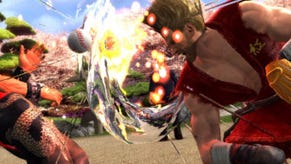
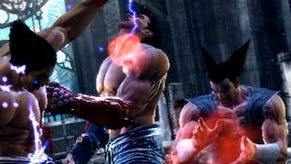

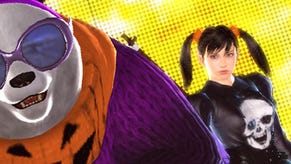
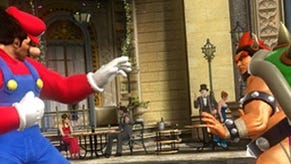
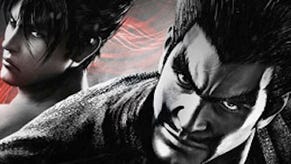
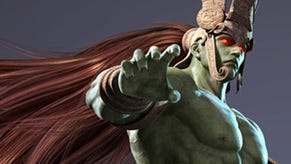
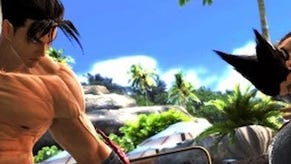
.png?width=291&height=164&fit=crop&quality=80&format=jpg&auto=webp)


